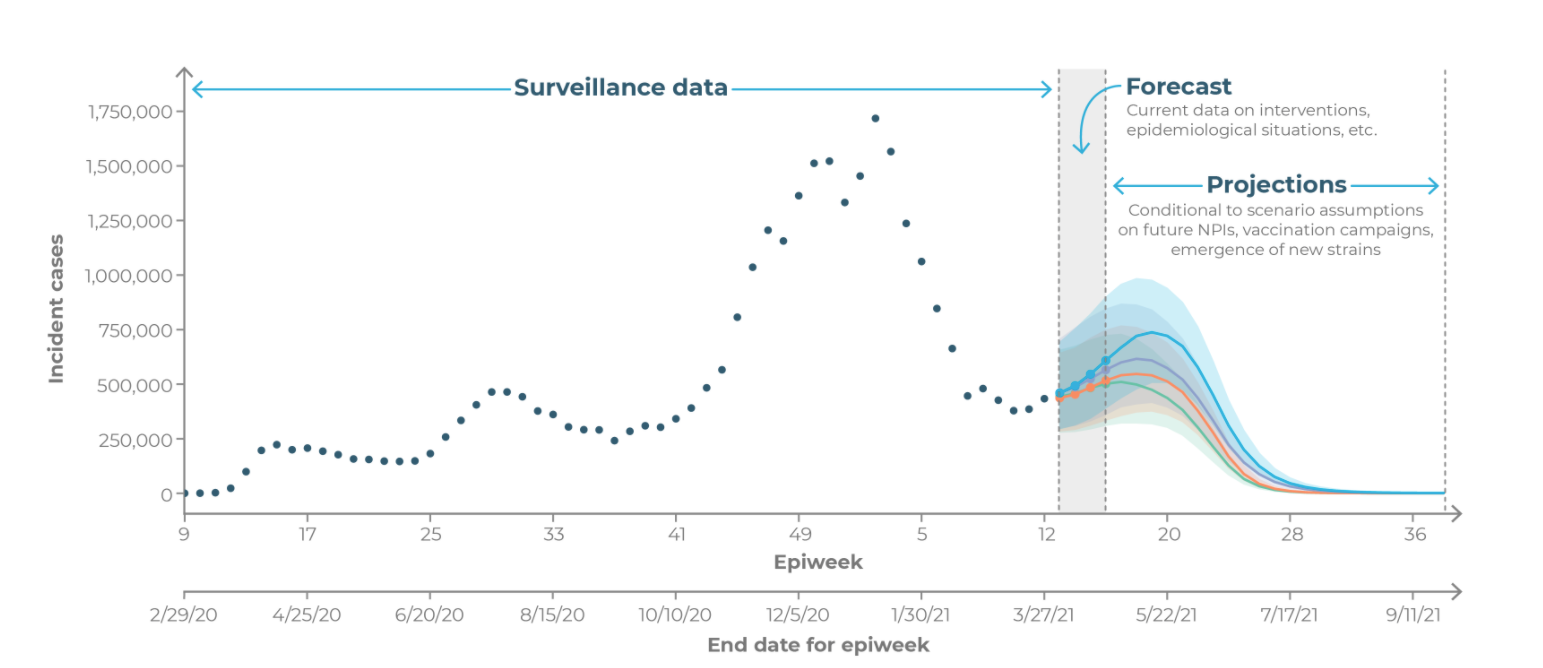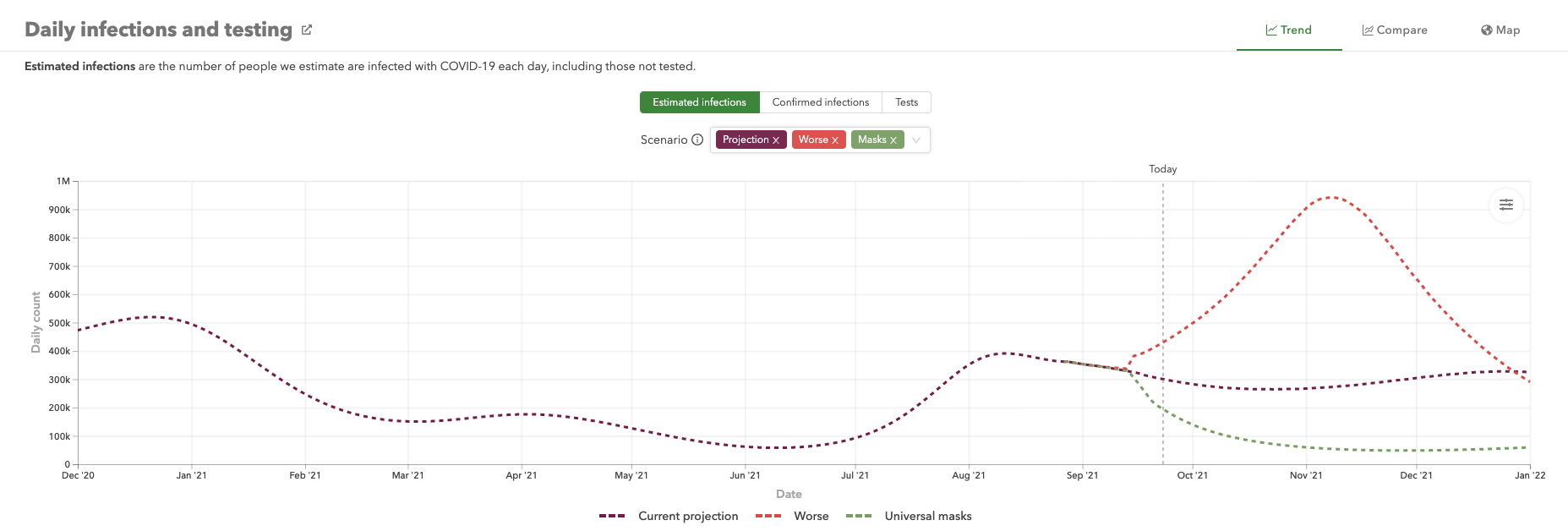Beginning of the End? Some Experts Predict COVID-19 Will Recede
If children get vaccinated and no new variant emerges, new infections will drop from 134,000 a day now to about 9,000 a day by March, according to 1 scenario. Deaths would fall to about 100 a day.
It’s not like some health care experts didn’t see this coming, and no one but no one will say it’s a lock—not after all the nasty surprises COVID-19 has sprung on us—but some indicators point to a steady and steep decline in SARS-CoV-2 over the fall and winter.
The rosier of the predictions hinge on 1 development and 1 nondevelopment. The former being the creation and launch of a COVID-19 vaccine for children (which could happen in the next few weeks) and the latter being the non-appearance of any new COVID-19 variant that’s as infectious as the Delta variant that fuels the current surge.
About 134,000 new cases of COVID-19 per day have been reported over the last week, about a 10% drop from the past 2 weeks. And while infections are rising in 27 states, they are falling in 23, according to Johns Hopkins University.
Mortality rates of 33% over the last 2 weeks (about 2000 people a day) tempers this hopeful news, but deaths are a lagging indicator.
One of the rosier scenarios comes from the COVID-19 Scenario Modeling Hub, which uses data from 9 different research groups. Justin Lessler, PhD, an epidemiologist at the University of North Carolina, who’s associated with the hub, tells NPR that if children get vaccinated and no new highly infectious variant emerges, new infections will drop from 134,000 a day now to about 9,000 a day by March. Deaths would fall to about 100 a day by March.
Source: COVID-19 Scenario Modeling Hub

Kevin Kavanagh, MD, a member of Infection Control Today®’s Editorial Advisory Board, says that “many were talking” about the chart above, but not everybody had the same interpretation.
“The graph appears to be an old model which was entirely not correct,” Kavanagh tells ICT®. “It predicted that COVID-19 would be gone by this August. This did not happen. Instead, we got Delta. Predicting the future of COVID-19 is like predicting the stock market. Unfortunately you have two unknowns; one is future human behavior and the other is viral mutations. The wide range of future projections from IHME illustrates this dilemma.”
Source: Institute for Health Metrics and Evaluation (IHME)

Cécile Viboud, an infectious disease epidemiologist at the National Institutes of Health’s Fogarty International Center, tells STAT that new cases by the end of November will be down to about where they were in late June and early July: between 7500 to 15,000 per day.
She tells STAT that “we’re probably going to stay there, because there is quite a bit of immunity in the population.”
However, both Lessler and Viboud do not seem willing to bet their house just yet that the worst is over.
Vibound: “That assumes that no new variant comes in. Because if you get a new variant that either has a higher transmissibility or immune escape potential, then we will see a resurgence.”
Lessler: “Any of us who have been following this closely, given what happened with Delta, are going to be really cautious about too much optimism. But I do think that the trajectory is towards improvement for most of the country.”
Maria Van Kerkhove, PhD

And, of course, not all experts are as optimistic. COVID-19 is a worldwide pandemic, and most of the world has not been vaccinated. According to the research organization, Our World in Data, 43.9% of the world’s population has received 1 dose of vaccine, with only 2.1% receiving 1 dose in low-income countries.
Maria Van Kerkhove, PhD, the top expert on COVID-19 at the World Health Organization tells STAT that there’s an expectation that COVID-19 will behave like influenza (already underway) and that’s a mistake.
She tells STAT: “I feel that a lot of people want it so badly to behave like flu. So that we can get into this pattern of ‘OK, in the summer everybody can relax. And then we just need to gear up for the fall. We need to get the vaccines underway. Get people vaccinated and just ride it out through that peak, that winter peak.’ But I don’t see that in the data that we have.”
Kavanagh also warns about comparing COVID-19’s behavior to that of the flu. He told ICT® in a Q&A in early August that “this is not the flu. You see countries that have had mass graves. I mean, how many times have you seen mass graves from the flu? You just don’t see it.”
Kavanagh has also argued that vaccinations must be seen as just one layer to the type of mitigation that will help the world return to pre-COVID-19 normal. He says social distancing, isolation precautions, lockdowns, hand hygiene and, especially, masking must be included.
Van Kerkhove seconds that.
STAT reports that “she believes human behavior—whether that’s wearing masks, social distancing, or getting vaccinated—has much more to do with declines of COVID transmission still than built-up immunity. The Delta variant hasn’t run through all the unprotected people, she insisted.”
Van Kerkhove tells STAT: “Delta still has a lot more energy in it.”